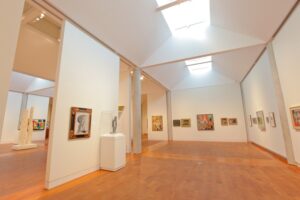
Today’s post comes from Sofía Benitez, class of 2018 and Art Center Student Docent.
Recently, the Frances Lehman Loeb Art Center acquired two series of vernacular photographs from the Peter J. Cohen collection. There has been a growing interest among museums in integrating vernacular photographs into their collecting missions and exploring how this medium became a cultural tool and symbol with its democratization. As photography became more accessible, people were able to document and sometimes aestheticize the memory of families, individuals, and cultures and render it in new forms. By turning the lens towards personal narratives that actively focus on the inner lives of their creators, we can access the past from a different standpoint that is often overlooked when the hierarchy of fine art prioritizes the visibility of strictly professional or published photographers. However, questions about visibility surface when looking at these photographs, of who is being depicted (and who isn’t), and what this reflects. Currently in the MFA there is an exhibit, also from the Peter J. Cohen Collection, titled Unfinished Stories. The title speaks to all that has been lost to us of the objects’ origins, intentions, and contexts as vernacular photographs, and in a sense idealizing these “unknowns.” This complicates our usage of these objects as materials for exhibition but provides an opportunity to critically engage with the role of art in systems of oppression, erasure, and reimagination, and how these operate within a larger social framework.

I worked with the two series selected by curator Mary-Kay Lombino and coordinator of academic programs Elizabeth Nogrady. The first is a series of photographs of women and the second, a family from the Hudson Valley. Ultimately, I created a 214-page catalogue that identifies each object (516 total) through title, author, medium, sheet and image size with inscriptions on verso and recto. In the case of the series of women, I was asked to provide possible groupings based on content, subject matter, and setting. Some examples of the groupings I suggested based on our photographs are “sole subject,” “portraits in front of cars,” “generational contrasts,” and “scenes of life indoors.” This exercise in finding patterns is also replicated in the exhibition at the MFA, which I visited last week. Their groups range from the documentation of transformations (dressing up, etc.) to “Couples,” “Hula Madness,” and children. Although this reordering of materials connects the photographs in new ways despite their temporal and likely geographical distance, it is nearly impossible not to wonder about the curatorial decisions made to place certain items together, and how few of the groupings challenge the male gaze, the gender binary, the visibility of heterosexual couples, the objectification of the body, affluent lifestyles, and middle-class leisure. Some of the same questions came to mind when looking at our own collection and noticing the lack of racial and class diversity in the series, instances of white women dressed in their idea of indigenous clothing, and the portrayal of the female body.
From nomenclature to groupings, working on this internship made me question the roles of museums, curators, and artistic institutions in the manipulation and presentation of materials. It underscored the potential to generate dialogue from art which identifies and speaks to patterns that are symptomatic of larger structures and systems that continue to operate in the oppression of communities and individuals in how they are presented (or withdrawn from) the public eye.




